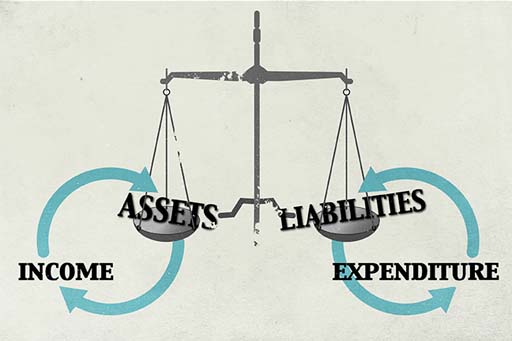6.3.5 Linking the balance sheet to income and expenditure
Let’s end this week by looking at the relationship between liabilities and expenditure, and assets and income.
This is summarised in the image, which describes the inter-relationship between the stocks of assets and liabilities and the flows of income and expenditure. Assets are on one side of the scales and liabilities on the other.
In reality, these scales would be in constant motion, as money continually flows into and out of individuals’ and households’ pockets, and the value of assets and liabilities is continuously changing. For the sake of simplicity, assume the scales have stopped at a particular point in time. This allows an exploration of both how assets relate to income and how liabilities relate to expenditure.
The receipt of income adds to the asset side of the household balance sheet (at least in the short term) as money flows, such as pay from employment, go into a current account. Alternatively, income can be used to purchase shares, bonds or other forms of saving and investments. In turn, many assets produce flows of income, such as interest payments or share dividends.
Non-financial assets (for instance, a piece of art) generally do not produce an income flow, and would have to be sold to generate money. Yet even these assets could theoretically produce an income, for example, lending a work of art to an exhibition for a fee.
Similarly, expenditure is related to liabilities in the sense that having debts generates future flows of expenditure. Expenditure either reduces assets – perhaps by depleting the current account or by causing other assets to be sold – or increases liabilities, perhaps by taking out debt to pay for it. Expenditure that is higher than income generates liabilities because individuals or households will have to take on debts, for example, by using credit cards or overdrafts, to fund the gap between expenditure and income.
To return to the subject of housing, it can be interesting to consider how homes fit into the household balance sheet. Homes are typically regarded as the biggest asset of an individual or household. Yet an interesting point put forward by Robert T. Kiyosaki in his famous book Rich Dad, Poor Dad: What the Rich Teach their Kids about Money – that the Poor and Middle Class Do Not! (Kiyosaki, 2011) is that one of the key mistakes contributing to making people ‘poor’ rather than ‘rich’ is buying a home that is bigger than strictly needed.
Rather than buying assets that produce income (like shares or investments), the large mortgage actually causes expenditure to escalate. It’s a salient point, which provides an interesting counterweight to the British dedication to house buying.

